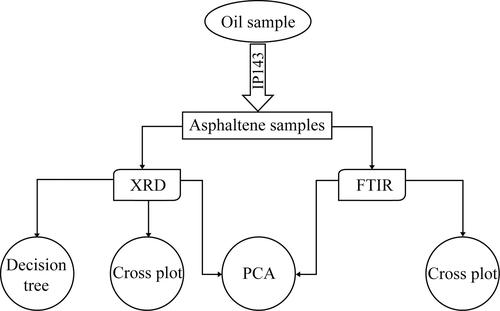当前位置:
X-MOL 学术
›
Acta Geol. Sinica Engl. Ed.
›
论文详情
Our official English website, www.x-mol.net, welcomes your
feedback! (Note: you will need to create a separate account there.)
Introducing a Novel Approach for Oil-Oil Correlation based on Asphaltene Structure: X-ray Diffraction
Acta Geologica Sinica-English Edition ( IF 3.5 ) Pub Date : 2021-03-30 , DOI: 10.1111/1755-6724.14709 Zahra Sadeghtabaghi 1 , Ahmad Reza Rabbani 1 , Abdolhossein Hemmati‐Sarapardeh 2, 3, 4
Acta Geologica Sinica-English Edition ( IF 3.5 ) Pub Date : 2021-03-30 , DOI: 10.1111/1755-6724.14709 Zahra Sadeghtabaghi 1 , Ahmad Reza Rabbani 1 , Abdolhossein Hemmati‐Sarapardeh 2, 3, 4
Affiliation

|
Asphaltenes have always been an attractive subject for researchers. However, the application of this fraction of the geochemical field has only been studied in a limited way. In other words, despite many studies on asphaltene structure, the application of asphaltene structures in organic geochemistry has not so far been assessed. Oil-oil correlation is a well-known concept in geochemical studies and plays a vital role in basin modeling and the reconstruction of the burial history of basin sediments, as well as accurate characterization of the relevant petroleum system. This study aims to propose the X-ray diffraction (XRD) technique as a novel method for oil-oil correlation and investigate its reliability and accuracy for different crude oils. To this end, 13 crude oil samples from the Iranian sector of the Persian Gulf region, which had previously been correlated by traditional geochemical tools such as biomarker ratios and isotope values, in four distinct genetic groups, were selected and their asphaltene fractions analyzed by two prevalent methods of XRD and Fourier-transform infrared spectroscopy (FTIR). For oil-oil correlation assessment, various cross-plots, as well as principal component analysis (PCA), were conducted, based on the structural parameters of the studied asphaltenes. The results indicate that asphaltene structural parameters can also be used for oil-oil correlation purposes, their results being completely in accord with the previous classifications. The average values of distance between saturated portions (dr) and the distance between two aromatic layers (dm) of asphaltene molecules belonging to the studied oil samples are 4.69Å and 3.54Å, respectively. Furthermore, the average diameter of the aromatic sheets (La), the height of the clusters (Lc), the number of carbons per aromatic unit (Cau), the number of aromatic rings per layer (Ra), the number of sheets in the cluster (Me) and aromaticity (fa) values of these asphaltene samples are 10.09Å, 34.04Å, 17.42Å, 3.78Å, 10.61Å and 0.26Å, respectively. The results of XRD parameters indicate that plots of dr vs. dm, dr vs. Me, dr vs. fa, dm vs. Lc, Lc vs. La, and fa vs. La perform appropriately for distinguishing genetic groups. A comparison between XRD and FTIR results indicated that the XRD method is more accurate for this purpose. In addition, decision tree classification, one of the most efficacious approaches of machine learning, was employed for the geochemical groups of this study for the first time. This tree, which was constructed using XRD data, can distinguish genetic groups accurately and can also determine the characteristics of each geochemical group. In conclusion, the obtaining of structural parameters for asphaltene by the XRD technique is a novel, precise and inexpensive method, which can be deployed as a new approach for oil-oil correlation goals. The findings of this study can help in the prompt determination of genetic groups as a screening method and can also be useful for assessing oil samples affected by secondary processes.
中文翻译:

介绍一种基于沥青质结构的油油关联新方法:X 射线衍射
沥青质一直是研究人员的一个有吸引力的课题。然而,仅以有限的方式研究了这部分地球化学领域的应用。换言之,尽管对沥青质结构进行了许多研究,但迄今为止尚未评估沥青质结构在有机地球化学中的应用。油-油对比是地球化学研究中的一个著名概念,在盆地建模和盆地沉积物埋藏历史的重建以及相关石油系统的准确表征中起着至关重要的作用。本研究旨在提出 X 射线衍射 (XRD) 技术作为油油对比的新方法,并研究其对不同原油的可靠性和准确性。为此,来自波斯湾地区伊朗部门的13份原油样品,之前通过传统地球化学工具(例如生物标志物比率和同位素值)在四个不同的遗传组中进行关联,并通过两种流行的 XRD 和傅里叶变换红外光谱 (FTIR) 方法分析其沥青质馏分。对于油油相关性评估,基于所研究的沥青质的结构参数,进行了各种交会图以及主成分分析 (PCA)。结果表明,沥青质结构参数也可用于油油对比,其结果与之前的分类完全一致。饱和部分之间的距离平均值 ( 选择并通过 XRD 和傅里叶变换红外光谱 (FTIR) 两种流行方法分析其沥青质馏分。对于油油相关性评估,基于所研究的沥青质的结构参数,进行了各种交会图以及主成分分析 (PCA)。结果表明,沥青质结构参数也可用于油油对比,其结果与之前的分类完全一致。饱和部分之间的距离平均值 ( 选择并通过 XRD 和傅里叶变换红外光谱 (FTIR) 两种流行方法分析其沥青质馏分。对于油油相关性评估,基于所研究的沥青质的结构参数,进行了各种交会图以及主成分分析 (PCA)。结果表明,沥青质结构参数也可用于油油对比,其结果与之前的分类完全一致。饱和部分之间的距离平均值 ( 基于所研究的沥青质的结构参数。结果表明,沥青质结构参数也可用于油油对比,其结果与之前的分类完全一致。饱和部分之间的距离平均值 ( 基于所研究的沥青质的结构参数。结果表明,沥青质结构参数也可用于油油对比,其结果与之前的分类完全一致。饱和部分之间的距离平均值 (d r ) 和属于所研究油样的沥青质分子的两个芳香层之间的距离 ( d m ) 分别为 4.69Å 和 3.54Å。此外,芳香片层的平均直径 ( L a )、簇的高度 ( L c )、每个芳香单元的碳数 ( C au )、每层的芳香环数 ( R a )、簇中的片层数 ( M e ) 和芳香性 ( f a) 这些沥青质样品的值分别为 10.09Å、34.04Å、17.42Å、3.78Å、10.61Å 和 0.26Å。XRD 参数结果表明,d r vs. d m、d r vs. M e、d r vs. f a、d m vs. L c、L c vs. L a和f a vs. L一个执行适当的区分基因组。XRD 和 FTIR 结果之间的比较表明,XRD 方法更准确地用于此目的。此外,决策树分类是最有效的机器学习方法之一,首次用于本研究的地球化学组。这棵树是利用 XRD 数据构建的,可以准确区分成因组,还可以确定每个地球化学组的特征。总之,通过 XRD 技术获取沥青质的结构参数是一种新颖、精确且成本低廉的方法,可作为油-油对比目标的新方法。
更新日期:2021-03-30
中文翻译:

介绍一种基于沥青质结构的油油关联新方法:X 射线衍射
沥青质一直是研究人员的一个有吸引力的课题。然而,仅以有限的方式研究了这部分地球化学领域的应用。换言之,尽管对沥青质结构进行了许多研究,但迄今为止尚未评估沥青质结构在有机地球化学中的应用。油-油对比是地球化学研究中的一个著名概念,在盆地建模和盆地沉积物埋藏历史的重建以及相关石油系统的准确表征中起着至关重要的作用。本研究旨在提出 X 射线衍射 (XRD) 技术作为油油对比的新方法,并研究其对不同原油的可靠性和准确性。为此,来自波斯湾地区伊朗部门的13份原油样品,之前通过传统地球化学工具(例如生物标志物比率和同位素值)在四个不同的遗传组中进行关联,并通过两种流行的 XRD 和傅里叶变换红外光谱 (FTIR) 方法分析其沥青质馏分。对于油油相关性评估,基于所研究的沥青质的结构参数,进行了各种交会图以及主成分分析 (PCA)。结果表明,沥青质结构参数也可用于油油对比,其结果与之前的分类完全一致。饱和部分之间的距离平均值 ( 选择并通过 XRD 和傅里叶变换红外光谱 (FTIR) 两种流行方法分析其沥青质馏分。对于油油相关性评估,基于所研究的沥青质的结构参数,进行了各种交会图以及主成分分析 (PCA)。结果表明,沥青质结构参数也可用于油油对比,其结果与之前的分类完全一致。饱和部分之间的距离平均值 ( 选择并通过 XRD 和傅里叶变换红外光谱 (FTIR) 两种流行方法分析其沥青质馏分。对于油油相关性评估,基于所研究的沥青质的结构参数,进行了各种交会图以及主成分分析 (PCA)。结果表明,沥青质结构参数也可用于油油对比,其结果与之前的分类完全一致。饱和部分之间的距离平均值 ( 基于所研究的沥青质的结构参数。结果表明,沥青质结构参数也可用于油油对比,其结果与之前的分类完全一致。饱和部分之间的距离平均值 ( 基于所研究的沥青质的结构参数。结果表明,沥青质结构参数也可用于油油对比,其结果与之前的分类完全一致。饱和部分之间的距离平均值 (d r ) 和属于所研究油样的沥青质分子的两个芳香层之间的距离 ( d m ) 分别为 4.69Å 和 3.54Å。此外,芳香片层的平均直径 ( L a )、簇的高度 ( L c )、每个芳香单元的碳数 ( C au )、每层的芳香环数 ( R a )、簇中的片层数 ( M e ) 和芳香性 ( f a) 这些沥青质样品的值分别为 10.09Å、34.04Å、17.42Å、3.78Å、10.61Å 和 0.26Å。XRD 参数结果表明,d r vs. d m、d r vs. M e、d r vs. f a、d m vs. L c、L c vs. L a和f a vs. L一个执行适当的区分基因组。XRD 和 FTIR 结果之间的比较表明,XRD 方法更准确地用于此目的。此外,决策树分类是最有效的机器学习方法之一,首次用于本研究的地球化学组。这棵树是利用 XRD 数据构建的,可以准确区分成因组,还可以确定每个地球化学组的特征。总之,通过 XRD 技术获取沥青质的结构参数是一种新颖、精确且成本低廉的方法,可作为油-油对比目标的新方法。











































 京公网安备 11010802027423号
京公网安备 11010802027423号